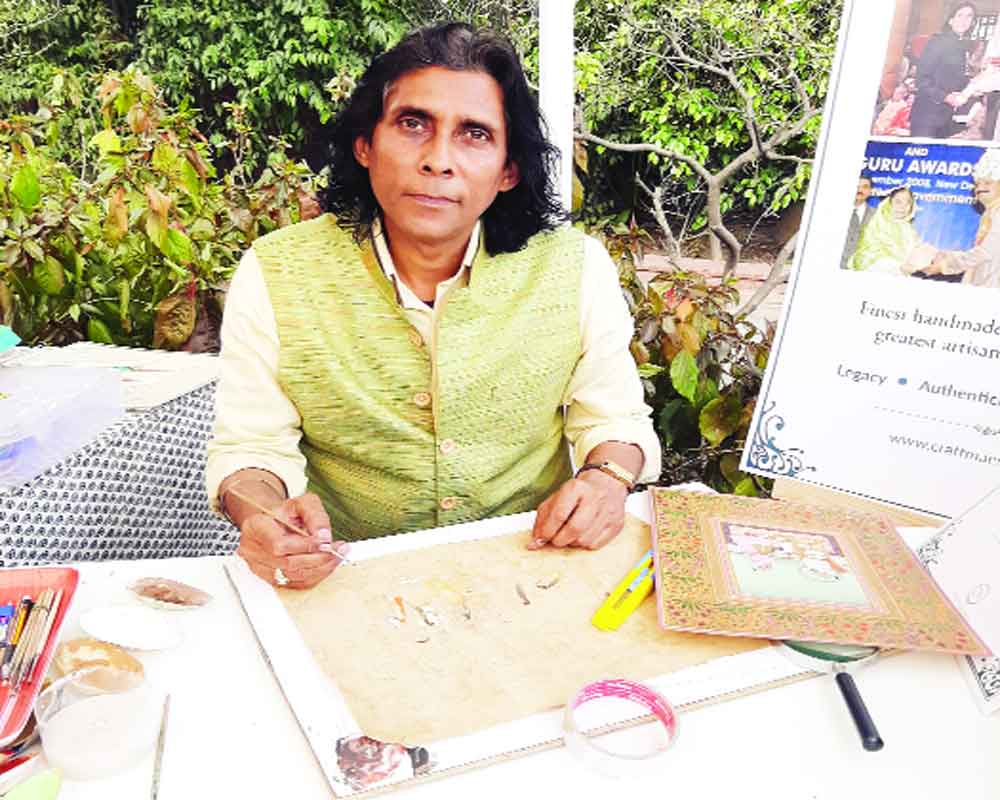MUSBA HASHMI catches up with Padma Shree awardee JAI PRAKASH, a self-taught painter who ranks amongst the top contemporary artists, who gives an insight into his journey
Dressed in a light-yellow kurta pyjama with a mehendi green koti, he was patiently sitting in his shop that had myriad paintings on the side. Hair style somewhat similar to that of director Imtiaz Ali, a smile of satisfaction and gratitude and adding to all that charisma a voice as humble as it can be. There was not even the slightest sign of pride in Padma Shree Awardee Jai Prakash’s personality. He recently showcased his work at Crafts Bazaar 2020 through Crafts Maestros, India’s first brand of handicrafts and handlooms.
Born to a train driver, Maliram in Delhi, Prakash was always interested in painting and is known as a self-taught artist. “Painting was my father’s hobby. Although he couldn’t take it up as a profession back in those days but he used to practice often. I was six when I started imitating him. That’s how I got interested in the craft. After completing Class XII, I went to seek admission in College of Art but couldn’t get through. That’s when I thought of pursuing the craft on my own. I looked up to my father for help and did the rest on my own. However, it was only after I got married that I got into the craft full-fledgedly,” he tells you.
Prakash calls himself a quick learner. It was because of this quality and not to mention the hard work that he got so much recognition in very less time.
“It was in 1992 when I started focusing on the craft. I learnt all the tips early and in 1996 received the State award. It didn’t stop there, I received the National Award in 1998. Then in 2016 I was honoured with the Padma Shree,” he tells you.
Prakash’s excellence lies in miniature paintings. However, miniature here doesn’t signify tiny paintings. “Miniature painting is just a style of painting. They can be as huge as to fit on a big wall. They didn’t derived their name because of their size but because of the minute details that they have. There is a lot of minute, intrinsic work done in these paintings. Hence, they are called miniature,” he explains. Natural colours, handmade brushes and papers are used in this form of painting.
“I prepare the colours on my own using all natural ingredients. The paper which I use is from the good old days. It is the same paper which was used by munshis (accountant) to keep a record of everything,” he adds.
The shelf life of miniature paintings is greater as compared to the normal ones because the natural paper absorbs the colour. While on the normal paper the colour remains only on the top and act as a layer on the paper. This way it can fade out easily after some time.
His inspiration comes from what he sees around and the people whom he meet.
“An idea can strike you in the middle of nowhere. I can be attending a party and would get to see something that I think is worth painting, I don’t sit specially to make a painting. It comes naturally,” Prakash says.
The price of the paintings depends upon the craftsmanship. “The more detailed the painting is, the higher its cost will be,” he says.
The minimum time to make a painting is around four days. However, if it’s a masterpiece, it would take as long as four months.
“Masterpieces are nothing but pure hardwork of an artist. An artist pours all the talent and expertise into that one painting. There is no boundation of time. Maybe the artist have to sit for 12 hours straight to complete a portion or it may be as less as 30 minutes,” Prakash says.
The idea of taking up painting as a profession didn’t sit too well with his family initially. “They used to say ‘yeh kya chitrakaari mein laga hai, kya hoga isse’. Par jab kaam aur daam dono milne laga, then they realised that art and crafts is a profession for real,” he says.
Prakash’s focus is to make three paintings in a year. “I want to give time to my creations. I don’t want to make anything in a hurry,” he says.
There is nothing like a favourite painting for Prakash as he has made all of them with the same enthusiasm. “But to name one it is Company Period,” he tells you.
Prakash has spent the most time in making Marriage Procession. “It took me 18 months to complete the painting. There was a lot of detailing and lot of figures in it. It was of 3 by 6.5 feet,” he tells you. It costed around `5 lakh.
Not only in India, Prakash has showcased his work in 34 countries. “I have represented India in different competitions in 34 countries around the globe,” he tells you. He is also invited by different colleges and universities around the work to teach students the craft.
Prakash has a message for all the aspiring artists. “The key in this profession is to adapt to changes. We have to keep in mind what the market requires. Our paintings should be in trend. They should resonate with the people. One who fails to do this loses his value and essence. Try to touch upon the subjects and trends that are prevalent in the society instead of what was liked years before from now. Also one should not solely depend on the Government for work. The Government does its bit by giving you a platform, rest is up to you. One has to make their way ahead and you cannot run away from struggle. Work doesn’t come to you, you have to search for it,” he says.


























